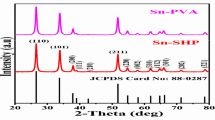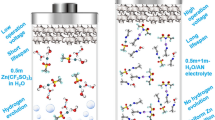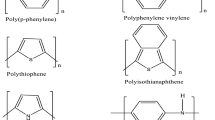Abstract
Polyaniline (PANI) salt was prepared with 3-(Cyclohexylamino)-1-propanesulfonic acid (CAPS) as a novel dopant by aqueous polymerization pathway. Effects of sodium lauryl sulfate surfactant, mineral acid (H2SO4), and a combination of surfactant with mineral acid during the polymerization reaction were also determined. PANI-CAPS showed semicrystalline with flake-like morphology. The use of the sodium lauryl sulfate along with CAPS resulted in the formation of highly crystalline nanospheres with flake-like morphology. In order to find out the effect of surfactant, sodium lauryl sulfate was used in the reaction. The combination of sodium lauryl sulfate, CAPS, and H2SO4 brings about an extended nanosphere morphology. These polyaniline salts were used as electrode materials in the supercapacitor application, in a symmetric two-electrode cell configuration. The values of specific capacitance, energy, and power densities of PANI-CAPS-DHS-H2SO4 material at 2 mA cm−2 were 495 F g−1, 90 kJ kg−1, and 120 J Kg−1 s−1, respectively. Moreover, 85 % of the original capacitance was retained after 3,000 galvanostatic charge–discharge cycles with a coulombic efficiency of 96–99 %. The value of phase angle is close to 90 at low frequencies, indicating a good capacitive behavior.








Similar content being viewed by others
References
Simon P, Gogotsi Y (2008) Materials for electrochemical capacitors. Nat Mater 7:845–854. doi:10.1038/nmat2297
Conway BE (1999) Electrochemical supercapacitors: scientific fundamentals and technological applications. Kluwer-Plenum, New York
Miller JR, Simon P (2008) Electrochemical capacitors for energy management. Science 321:651–652. doi:10.1126/science.1158736
Zheng JP, Cygan PJ, Jow TR (1995) Hydrous ruthenium oxide as an electrode material for electrochemical capacitors. J Electrochem Soc 142:2699–2703. doi:10.1149/1.2050077
Frackowiak E, Be´guin F (2001) Carbon materials for the electrochemical storage of energy in capacitors. Carbon 39:937–950. doi:10.1016/S0008-6223(00)00183-4
Zhang LL, Zhao XS (2009) Carbon-based materials as supercapacitor electrodes. Chem Soc Rev 38:2520–2521. doi:10.1039/B813846J
Lokhande CD, Dubal DP, Joo OS (2011) Metal oxide thin film based supercapacitors. Curr Appl Phys 11:255–270. doi:10.1016/j.cap.2010.12.001
Deng W, Ji X, Chen Q, Banks CE (2011) Electrochemical capacitors utilising transition metal oxides: an update of recent developments. RSC Adv 1:1171–1178. doi:10.1039/C1RA00664A
Snook GA, Kao P, Best AS (2011) Conducting-polymer-based supercapacitor devices and electrodes. J Power Sources 196:1–12. doi:10.1016/j.jpowsour.2010.06.084
Bhadra S, Khastgir D, Singha NK, Lee JH (2009) Progress in preparation, processing and applications of Polyaniline. Prog Polym Sci 34:783–810. doi:10.1016/j.progpolymsci.2009.04.003
Sydulu S, Palaniappan S (2013) Recent advances in the approach of polyaniline as electrode for supercapacitor. Nova, New York
Chiolerio A, Bocchini S, Porro S (2014) Inkjet printed negative supercapacitors: Synthesis of -polyaniline-based inks, doping agent effect, and advanced electronic devices applications. Adv Funct Mater 24:3375–3383. doi:10.1002/adfm.201303371
Bocchini S, Chiolerio A, Porro S, Accardo D, Garino N, Bejtka K, Perrone D, Pirri CF (2013) Synthesis of polyaniline-based inks, doping thereof and test device printing towards electronic applications. J Mater Chem C 1:5101–5109. doi:10.1039/c3tc30764f
Rajender B, Palaniappan S (2014) Emeraldine base form of polyaniline nanofibers as new, economical, green and efficient catalyst for synthesis of Z-aldoximes. J Catalysts 2014:1–6. doi:10.1155/2014/515428
Gupta B, Prakash R (2009) Synthesis of processible doped polyaniline-polyacrylic acid composites. J Appl Polym Sci 114:874–882. doi:10.1002/app.3055410.1155/2014/515428
Jinish Antony M, Jayakannan M (2010) Molecular template approach for evolution of conducting polymer nanostructures: Tracing the role of morphology on conductivity and solid state ordering. J Phys Chem B 114:1314–1324. doi:10.1021/jp910636s
Acknowledgments
The authors thank the Department of Science and Technology, New Delhi, India for funding under the project DST/TSG/PT/2011/179-G. The authors thank Dr. Lakshmi Kantam, Director, CSIR-IICT for her support and encouragement. The authors also thank Dr. Vijayamohanan K. Pillai, Director, CSIR—CECRI, Karaikudi for his valuable suggestion. Authors BR and BR are thankful to UGC, India for providing research fellowship.
Author information
Authors and Affiliations
Corresponding author
Rights and permissions
About this article
Cite this article
Bolagam, R., Boddula, R. & Srinivasan, P. Synthesis of highly crystalline polyaniline with the use of (Cyclohexylamino)-1-propanesulfonic acid for supercapacitor. J Appl Electrochem 45, 51–56 (2015). https://doi.org/10.1007/s10800-014-0753-4
Received:
Accepted:
Published:
Issue Date:
DOI: https://doi.org/10.1007/s10800-014-0753-4




